
components
Hardware Components
W7100
X 1
Fire Parameters Detecting Module
X 1
CO gas detecting unit
X 1
Infrared photoelectric smoke detecting unit
X 1
details
I. INTRODUCTION
A fire will generate heat, gases, smoke, flames, and combustion waves and so on [1]. These parameters can be used to indicate fire occurrence. Nowadays, there are several kinds of fire detector, for instance, smoke detector, flame detector, temperature detector and combination detector. The wiring of a fire detecting system is also various, such as multiple wire system and bus system. In recent years, the development trend of bus system march towards networking. In order to alarm the fire as early as possible and eliminate distortion fire, combination detector which can detect CO gas and smoke [2] is adopted. The network of this system is build up based on Ethernet which is the most wildly used LAN (Local Area Network) communication protocol standards. Data transmission of the system is based on TCP/IP (Transmission Control Protocol/Internet Protocol) [3]. As a mature technology, it provides a reliable transmission.
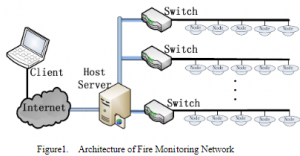
II. NETWORK NODE OF COMPLEX FIRE DETECTION
Fire detectors are deployed in the monitoring area. The detector includes three parts: the module of control & communication, the module of fire parameters detection and power supply. Control & communication module handles the process of converting and transmits the data to the Ethernet.
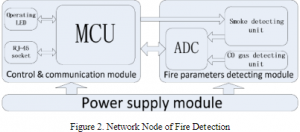
A. The module of Control & communication
B. Fire Parameters Detecting Module
I) CO gas detecting unit
In the design, a kind of semiconductor sensor is used to detect CO gas. It is made of 2 SnO in polycrystalline structure [5]. This kind of sensor has wide detecting range from 10ppm to 2000ppm, a very good stability and long life span. At about 200℃, the oxygen is absorbed on the crystal surface, and negative charges are generated. In this situation, the electrons on the crystal surface move to the oxygen, forming a positive space charge layer. In this way, a potential-energy barrier is built up and electric current would be resisted by it.
II) Infrared photoelectric smoke detecting unit
Photoelectric smoke detecting unit is composed of a pair of infrared emitter and receiver diodes, an optical maze and insect screen. The infrared LED and photodiode are fixed in optical maze. The optical maze acts as an indispensable role to form the smoke particle detecting space. The V-shaped shield can resist the light outside and allow the smoke particles entering
into the detecting space; the zigzag stripes on the bottom.
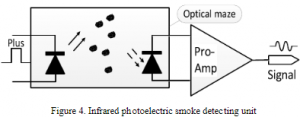
A. Software on MCU
The transmission between node and host computer is based on TCP. TCP is one of the core protocols of the Internet Protocol Suite. It provides the service of exchanging data directly between two hosts on the same network, whereas IP handles addressing and routing message across one or more networks. In particular, TCP provides reliable, ordered delivery of a stream of bytes from a program on one computer to another program on another computer. The server shakes hand with node by SYN (synchronize). When physical layer is ready, server will send a connect-request to the node. The link is created if the node sends back an ACK (Acknowledge Character) signal. After that, node and server can execute data transmission to each other. The server connects to all the nodes in the same way and sends data request constantly. W7100 acquires data from ADC once per second, processes the data and refresh the value in network transmission buffer.
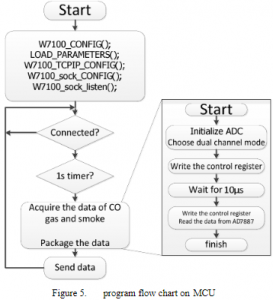
B. Software & Configure of System
The application processes the data from nodes, display the values of CO and smoke in Standard unit. At the same time, the application syncretizes the data from several adjacent nodes, judges the fire by Neural-Net Algorithms to reduce the false alarm rate. If a fire is confirmed, the server will send a message to the fire department and invoke the emergency system in the building. Fire department can also get the raw data from the server. Each IP address corresponds to a node and indicates a monitoring area, from the data fire department can more easily to locate the fire and take appropriate measures.
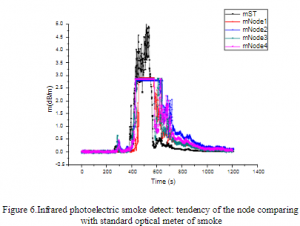
IV. EXPERIMENT AND DATA ANALYZE
Experiments show that this design is feasible. The network deployment is easy and convenient; nodes can gather the information in the monitoring area accurately. The national standard GB 4715-2005 [7] provides technical requirements and test methods for point type smoke fire detectors. The nodes are standardized in standard fire experimental lab, comparing with standard optical density meter of smoke. The voltage value would be converted into light extinction m, which indicates the rate of light that is reduced by the smoke particles and can be defined.

V. CONCLUSION
The system applies multiple detecting nodes to work together and dual-parameter to identify the fire accurately. The nodes have good stability and reliability, with high sensitivity and shorter response time. By detecting the CO concentration as a fire parameter, nodes can detect the fire quickly. Due to Ethernet, the network is easy to build up and the data transmission is safe and fast. Ethernet enables the system access to the Internet, as a trend of Internet of things. The fire monitoring system based on Ethernet is a feasible design for modern buildings.


COMMENTS